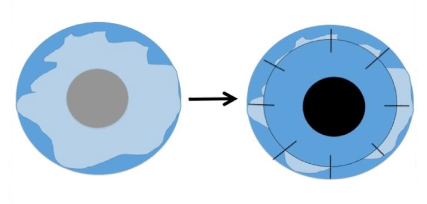PK
چهار شنبه 29 فروردین 1397
بازدید: 1325
Corneal transplantation: penetrating keratoplasty (PK)
Why would I need a corneal transplant?
The cornea is a window of transparent tissue at the front of the eyeball. It allows light to pass into the eye and provides focus so that images can be seen. Various diseases or injury can make the cornea either cloudy or out of shape. This prevents the normal passage of light and affects vision.
A cloudy cornea can be replaced by a healthy one from a donor to restore vision. (See picture below)
If the full thickness of the cornea is affected by disease, then a full thickness transplant is performed. This is known as a penetrating keratoplasty.

Benefits of penetrating keratoplasty
Improved vision
- Approximately 75% of transplant recipients have good enough vision to drive legally but usually need glasses or contact lenses or sometimes further surgery for best results
- It may take up to 24months until the full improvement in vision is seen.
Risks of penetrating keratoplasty
- Rare but serious complications
- Sight-threatening infection (1 in 1,000)
- Severe hemorrhage causing loss of vision
- Retinal detachment
- Severe inflammation or other rare causes of vision loss.
Corneal transplant rejection
A corneal transplant may be rejected by your immune system. This happens in one in six patients in the first two years after transplantation and can cause graft failure. It can often be reversed if anti-rejection medication is started promptly, but rejection remains a possibility in your lifetime.
Graft failure
When a graft fails, your cornea becomes cloudy again and your vision becomes blurred.
Glaucoma
This can usually be controlled by eye drops, but occasionally requires surgery and may harm your sight.
Cataract
This can be removed surgically.
About the operation
The operation is performed under general anesthetic and takes about one hour. A central 8mm button of your cornea is removed and a similar-sized button of the donor cornea is stitched in with tiny stitches. These cannot be felt or seen. Sometimes the abnormal cornea, which is removed, is sent to our pathology laboratory for examination under a microscope.
After the operation
You will usually be examined by the surgical team after the surgery and can generally go home the same day. You will be seen again within one week in the outpatient clinic and regularly thereafter (approximately six visits in the first year).We generally recommend that you take two weeks off work but please discuss your individual circumstances with your doctor. You will need to use anti-rejection eye drops for at least six months and indefinitely in some cases. Individual stitches may be removed from three months after the operation, but complete stitch removal is not performed until at least one year after the procedure.
What if my transplant fails?
A failed transplant can be replaced in a procedure known as a regraft. However, the risk of further rejection and failure increases each time for subsequent regrafts.
Corneal transplant rejection
Rejection needs urgent treatment as this can lead to failure of the transplant and loss of vision. Symptoms of rejection are:
- Red eye
- Sensitivity to light
- Visual loss
- Pain
If you experience any of these symptoms you should come immediately to our 24-hour emergency department.
دیدگاه های ارسال شده توسط شما، پس از تایید مدیر سایت در وب سایت منتشر خواهد شد.
پیام هایی که حاوی تهمت یا افترا باشد منتشر نخواهد شد.
پیام هایی که به غیر از زبان فارسی یا غیر مرتبط با خبر باشد منتشر نخواهد شد.